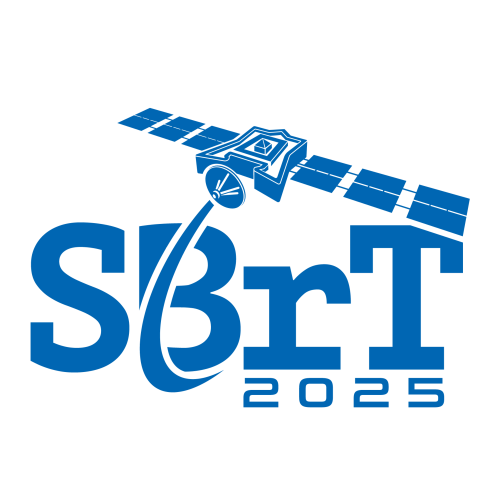
XLIII Simpósio Brasileiro de Telecomunicações e Processamento de Sinais
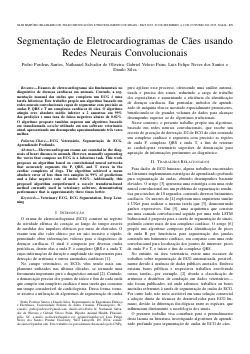
Segmentação de Eletrocardiogramas de Cães usando Redes Neurais Convolucionais
Pedro P Santos, Nathaniel S de Oliveira, Gabriel V Paim, Luis F. N. dos Santos, Danilo Silva
DOI: 10.14209/sbrt.2025.1571149900
Keywords:
Abstract
Electrocardiogram exams are essential in the diagnosis of heart diseases in animals. However, manually segmenting the waves that compose an ECG is a laborious task. This work proposes an algorithm based on convolutional neural networks that accurately segments the P, QRS, and T waves in the cardiac complexes of dogs. The algorithm achieved a mean absolute error of less than two samples in 99% of predictions and a false negative rate of under 0.02%. Additionally, this proposed algorithm outperformed a wavelet transform-based method currently used in veterinary software, demonstrating performance that is approximately three times better.Download

Hierarchical Ship Classification Employing a Multi-Level Framework Based on YOLOv11: Enhancing Accuracy in Similar Class Differentiation
Eduardo Henrique Teixeira, Samuel Mafra, Felipe Augusto Pereira de Figueiredo
DOI: 10.14209/sbrt.2025.1571150190
Keywords: YOLOv11 Hierarchical Ship Classification Detection
Abstract
This work proposes a hierarchical approach for ship classification in optical images, aiming to improve the separation between classes with high visual similarity. The strategy employs two stages based on the YOLOv11 architecture, with the first stage using a generalist detector that groups similar classes to reduce classification complexity and the second stage applying a specialized classifier to distinguish between subcategories. Experiments conducted with the InaTechShips dataset showed that the hierarchical framework increased the mAP from 96.3% to 98.6% and improved classification accuracy for the similar classes from 83.46% to 91.03%.Download

Modelagem de atenção audiovisual em vídeos imersivos: impactos do áudio na dispersão ocular
Felipe M Ximenes, João Vitor Rodrigues Barros, Ronaldo F Zampolo, Aline F. G. Sousa
DOI: 10.14209/sbrt.2025.1571150391
Keywords: Modelagem de atenção audiovisual Videos 360 Fixações
Abstract
Esta pesquisa investiga a influência do áudio na atenção visual em vídeos imersivos, através da análise da dispersão das fixações oculares. Utilizando dados de rastreamento ocular de cerca de 20 observadores, foram comparadas medidas de dispersão espacial das fixações oculares registradas para vídeos com e sem áudio. Os resultados indicam que o áudio reduz a variabilidade espacial das fixações, promovendo maior convergência da atenção visual. Esses achados reforçam a importância da integração multimodal na modelagem computacional da atenção visual e apontam o áudio como componente essencial no treinamento de modelos preditivos em vídeos imersivos.Download
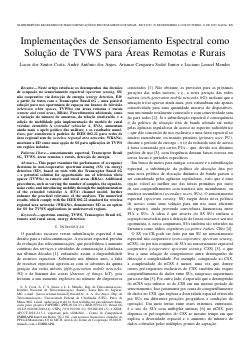
Implementações de Sensoriamento Espectral como Solução de TVWS para Áreas Remotas e Rurais
Lucas dos Santos Costa, André Antônio Anjos, Arismar Cerqueira Sodré Junior, Luciano Leonel Mendes
DOI: 10.14209/sbrt.2025.1571150396
Keywords: spectrum sensing TVWS remote and rural areas energy detection
Abstract
In this article, the performances of occupancy decisions in non-cooperative spectrum sensing (SS) via energy detection (ED) are studied based on tests with the Transceptor Brasil 6G, a potential (TV white space, TVWS) solution for remote and rural areas. Additional procedures such as varying the number of samples, the signal-to-noise ratio, and introducing mobility further enhance the practical relevance of the analyses, and the results show ED as a viable option for SS in the context of TVWS applications in these areas.Download
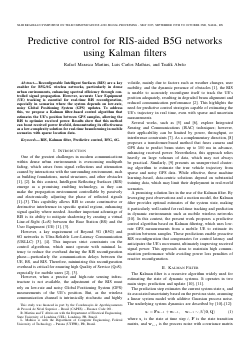
Predictive control for RIS-aided B5G networks using Kalman filters RIS, Kalman filter, Predictive control, B5G, 6G
Rafael Marasca Martins, Luis Carlos Mathias, Taufik Abrão
DOI: 10.14209/sbrt.2025.1571150404
Keywords:
Abstract
Reconfigurable Intelligent Surfaces (RIS) are anticipated to be a key enabling technology for beyond 5G (B5G) and 6G wireless networks, introducing the concept of a controllable radio environment. By dynamically shaping the propagation of electromagnetic waves, RIS can significantly enhance spectral efficiency and support communication in densely populated scenarios. However, one of the main challenges in deploying RIS lies in the design of effective beamforming control algorithms. In high-mobility scenarios, accurately and continuously tracking the user equipment (UE) position is essential to allow timely RIS reconfiguration and prevent signal degradation. When advanced sensing infrastructure is unavailable, the system must rely on low-rate and potentially unreliable GPS updates, which hinders real-time responsiveness. To address this, we propose a Kalman filter-based control algorithm that estimates the UE's position between GPS samples, enabling the RIS to adaptively optimize the received power. The results demonstrate that the Kalman filter approach can yield up to a fivefold improvement in the received power at the UE. This highlights the effectiveness of the proposed method as a low-complexity yet powerful solution for enabling real-time beamforming in mobile scenarios with sparse location measurements.Download

PointPCA2-RS: PointPCA2 with Resource Saving
Arthur Henrique Silva Carvalho, Pedro Garcia Freitas
DOI: 10.14209/sbrt.2025.1571150580
Keywords: Point cloud quality assessment resource saving 3d signal processing
Abstract
This paper introduces PointPCA2-RS, a lightweight version of PointPCA2 with emphasis on low computational resources usage. PointPCA2-RS optimizes the original PointPCA2 by re-implementing it using a different programming language, structure, and specific algorithmic details. Designed to evaluate visual quality, both projects extract identical features from point cloud (PC) data. Their core functionalities are similar, including Principal Component Analysis (PCA) on local geometric data, computation of spatial and geometric descriptors, and feature pooling and aggregation. These attributes result from a programming language change, affecting architecture and performance. PointPCA2-RS adopts a modular approach opti- mized for performance and maintainability, being more suitable for large-scale or real-time applications. Experimental results demonstrate the high performance of PointPCA2-RS against PointPCA2 without sacrificing prediction accuracy. PointPCA2- RS outperforms state-of-the-art point cloud quality assessment (PCQA) metrics, offering significant improvements for PCQA field. The code of PointPCA2-RS metric is available at https: //github.com/arthurhscarvalho/pointpca2-rs.Download
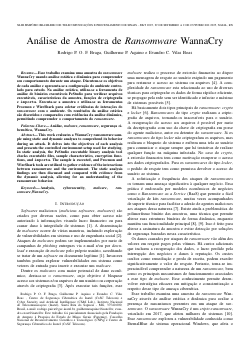
Análise de Amostra de Ransomware WannaCry
Rodrigo Paiva De Oliveira Ferreira Braga, Guilherme Pedro Aquino, Evandro Cesar Vilas Boas
DOI: 10.14209/sbrt.2025.1571150918
Keywords:
Abstract
Esse trabalho examina uma amostra do ransomware WannaCry usando análise estática e dinâmica para compreender seu comportamento durante um ataque. Discutem-se os objetivos de cada análise e apresenta-se a configuração do ambiente controlado para estudo. Na análise estática, utiliza-se a ferramenta de análise de binários executáveis PeStudio para verificar arquivos executáveis, características da amostra, funções de criptografia e imports. Executa-se a amostra e utiliza-se as ferramentas Procmon e WireShark para coletar evidências de interações do ransomware com o ambiente. Os resultados da análise estática são discutidos e comparados com evidências da análise dinâmica, permitindo compreender o comportamento do ransomware.Download
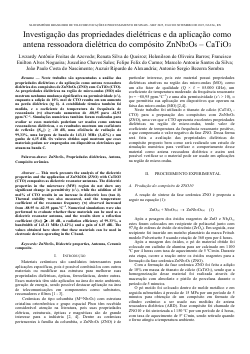
Investigação das das propriedades dielétricas do compósito ZnNb2O6 - CaTiO3
Lwzardy Antônio Freitas De Azevedo, Renata Silva de Queiroz, Helenilson de Oliveira Barros, Raphael Victor Barros Campos, Francisco Enilton Alves Nogueira, Juscelino Chaves Sales, Felipe Felix do Carmo, Marcelo Antonio Santos da Silva, João Paulo Costa do Nascimento, Auzuir Ripardo de Alexandria, Antonio Sergio Bezerra Sombra
DOI: 10.14209/sbrt.2025.1571151062
Keywords:
Abstract
Neste trabalho são apresentadas a análise das propriedades dielétricas da antena dos compósitos de ZnNb2O6 (ZNO) com CaTiO3 (CTO). As propriedades dielétricas na região de micro-ondas (MW) não mostram nenhuma mudança significativa na permissividade (ε'r), enquanto a adição de 10% mol de CTO resulta em um aumento na perda dielétrica (tg δ). A estabilidade térmica também foi medida, e o coeficiente de temperatura da frequência de ressonância (τf) observado aumentou de -88,95 para -62,93 ppm.°C−1. Simulações numéricas também foram realizadas para avaliar se esses materiais para uso como uma antena ressonadora dielétrica, e os resultados mostram um coeficiente de reflexão (|S11|) ≥ -10 dB, uma eficiência de radiação de 99,33%, uma largura de banda variando de 143,11 MHz e um ganho de 6,15 dBi. Os valores obtidos aqui mostram que esses materiais podem ser empregados em dispositivos eletrônicos que atuam na banda C.Download
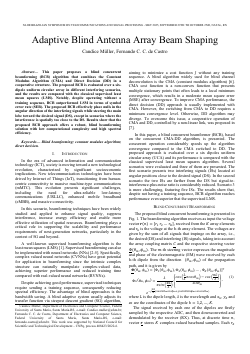
Blind Concurrent Beamforming
Candice Muller, Fernando de Castro
DOI: 10.14209/sbrt.2025.1571151076
Keywords:
Abstract
This paper proposes a blind concurrent beamformer (BCB) algorithm that combines the Constant Modulus Algorithm (CMA) and Direct Decision (DD) in a cooperative structure. The proposed BCB is evaluated over a six-dipole uniform circular array in different interfering scenarios, and the results are compared with the classical supervised least mean squares (LMS). Notably, despite operating without a training sequence, BCB outperformed LSM in terms of symbol error rate (SER). The proposed BCB effectively place nulls in the angular direction of the interfering signals while steering the main lobe toward the desired signal (DS), except in scenarios where the interference is spatially too close to the DS. Results show that the proposed BCB approach offers a robust, blind beamforming solution with low computational complexity and high spectral efficiency.Download
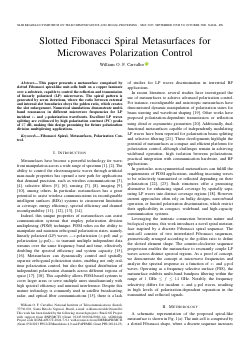
Slotted Fibonacci Spiral Metasurfaces for Microwaves Polarization Control
William O. F. Carvalho
DOI: 10.14209/sbrt.2025.1571151090
Keywords: Fibonacci Spiral Metasurfaces Polarization Control
Abstract
This paper presents a metasurface comprised by slotted Fibonacci spiral-like unit-cells built on a copper laminate over a substrate, capable to control the reflection and transmission of linearly polarized (LP) microwaves. The spiral pattern is generated by seven iterations, where the ratio between external and internal slot boundaries obeys the golden ratio, which creates the slot enlargement. Numerical simulations demonstrate multi-band resonances in different microwave frequencies for LP incident x- and y-polarization wavefronts. Excellent LP waves splitting are evidenced by high cross-talk peaks of 27dB, making this design promising for future polarization division multiplexing applications.Download